ASRock X79 Extreme4-M and X79 Extreme4 Review – Sandy Bridge-E meets mATX
by Ian Cutress on December 9, 2011 12:00 PM EST- Posted in
- Motherboards
- ASRock
- X79
USB Speed
For this benchmark, we run CrystalDiskMark to determine the ideal sequential read and write speeds for the USB port using our 64GB Patriot SuperSpeed USB 3.0 drive. Then we transfer a set size of files from the SSD to the USB drive, and monitor the time taken to transfer. The files transferred are a 1.52 GB set of 2867 files across 320 folders – 95% of these files are small typical website files, and the rest (90% of the size) are the videos used in the Sorenson Squeeze test.
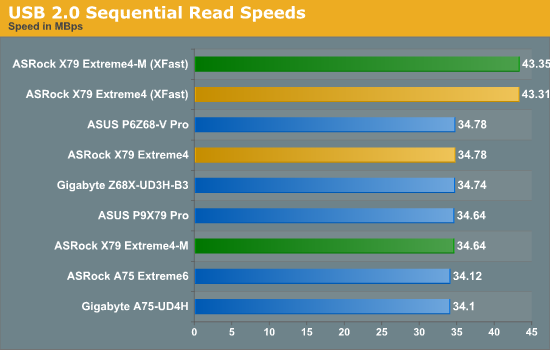
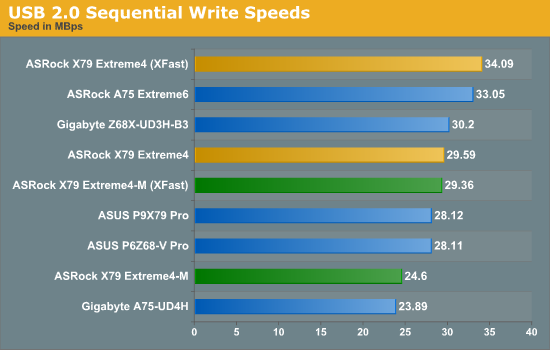
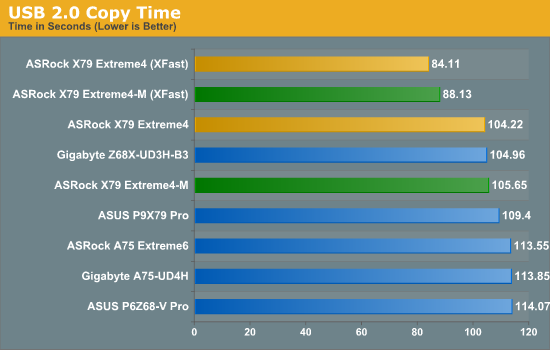
Despite the poor sequential performance of the Extreme4-M, under XFast mode, both boards outperform the rest in the USB 2.0 copy tests, especially the Extreme4.
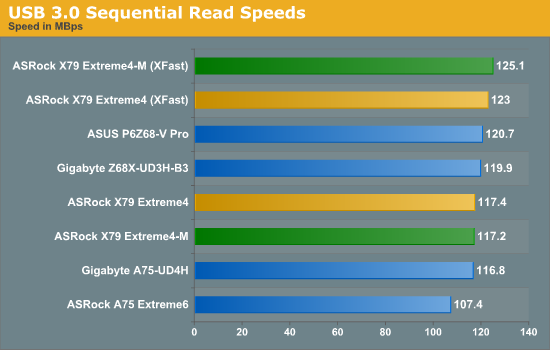
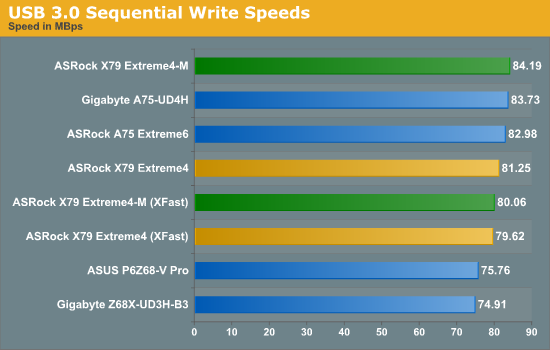
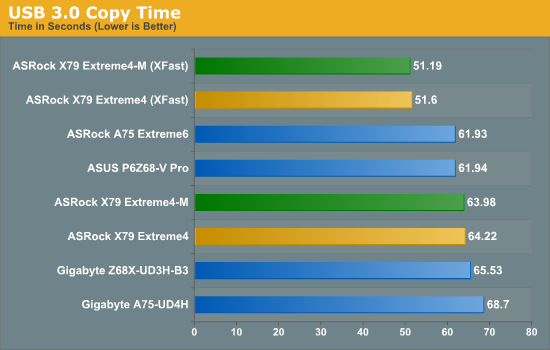
Both boards, under XFast mode, steam past all the other boards in our USB 3.0 copy test, with a 20% decrease in time required.
SATA Testing
We also use CrystalDiskMark for SATA port testing. The operating system is installed on the SSD, and the sequential test is run at the 5 x 1000 MB level. This test probes the efficiency of the data delivery system between the chipset and the drive, or in the case of additional SATA ports provided by a third party controller, the efficiency between the controller, the chipset and the drive.
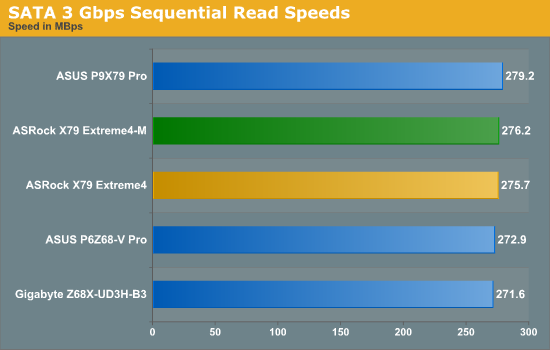
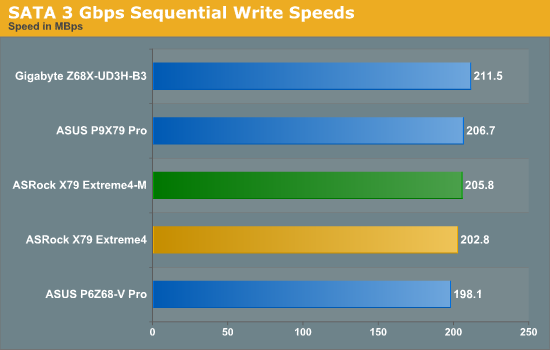
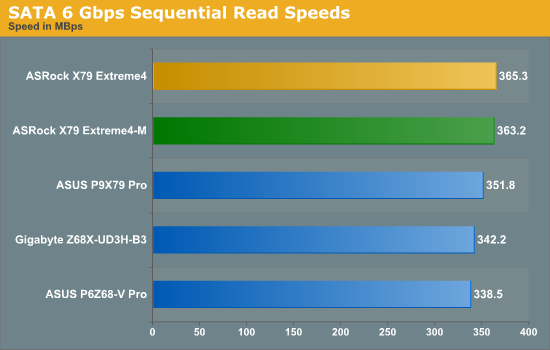
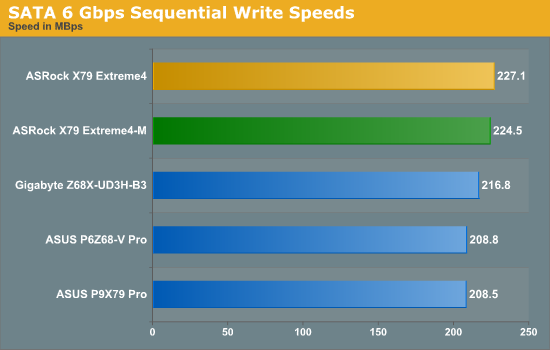
While neither board shines in SATA 3 Gbps testing, in terms of SATA 6 Gbps on our C300, both the X79 Extreme4 and X79 Extreme4-M beat the other X79 and Z68 comparison points.
DPC Latency
Deferred Procedure Call latency is a way in which Windows handles interrupt servicing. In order to wait for a processor to acknowledge the request, the system will queue all interrupt requests by priority. Critical interrupts will be handled as soon as possible, whereas lesser priority requests, such as audio, will be further down the line. So if the audio device requires data, it will have to wait until the request is processed before the buffer is filled. If the device drivers of higher priority components in a system are poorly implemented, this can cause delays in request scheduling and process time, resulting in an empty audio buffer – this leads to characteristic audible pauses, pops and clicks. Having a bigger buffer and correctly implemented system drivers obviously helps in this regard. The DPC latency checker measures how much time is processing DPCs from driver invocation – the lower the value will result in better audio transfer at smaller buffer sizes. Results are measured in microseconds and taken as the peak latency while cycling through a series of short HD videos - under 500 microseconds usually gets the green light, but the lower the better.
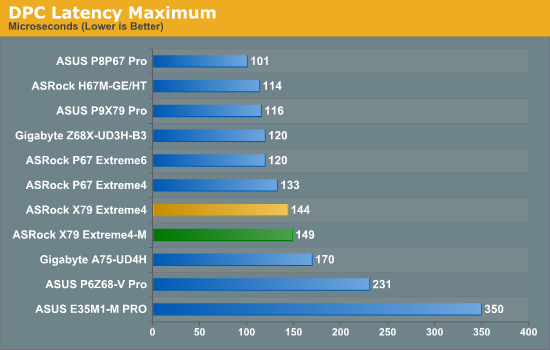
DPC Latency seems to be majorly dependent on the BIOS - it also helps if there is no CPU/fan monitoring software in the background. Both boards here perform well under 500 microseconds, but nothing stellar compared to other products.










54 Comments
View All Comments
LauRoman - Friday, December 9, 2011 - link
Considering that inserting a pcie expansion card in a x16 (x8) slot could, on old chipsets/moterboards screw around with your 2/3/4 way sli/x-fire bandwith let's not kill it just yet.ckryan - Friday, December 9, 2011 - link
Intel chipsets don't have native PCI support anymore. You have to use a PCIe to PCI PLX chip on the motherboard to get the support. That means you're giving up PCIe bandwidth (probably not a big deal), but also PCI support is spotty. I have one SB board (an Intel DP67BG) that doesn't really work with any PCI soundcard (they've not been able to fix this with UEFI updates).
But at some point you just have to decide that you're going to not use PCI anymore, and people who refuse to replace their old busted sound card or bunk networking device are holding us all back. PCI is terrible, and I'd much have a PCIe x1 slot or no slot at all.
Wireless adapters are just as cheap in PCIe x1 as PCI, and gigabit ethernet is hamstrung by PCI as it's just not very fast. Soundcards are available from Asus and Creative in PCIe for cheap. I've got a Asus Essence STX PCIe which was more expensive, but why the hell would you buy the PCI version (which was more expensive) in 2011?
sylar365 - Friday, December 9, 2011 - link
My "old, busted" soundcard.http://www.newegg.com/Product/Product.aspx?Item=N8...
Got something that sounds better without bloatware available in PCIe? Besides, most audio chips currently being produced and placed on PCIe sound cards still require a PLX chip in order to convert from the PCI standard to use the PCIe form factor.
IMHO i wish they would kill PCI - AND THEN - make decent sound hardware available for PCIe slots. Admittedly there have been a couple of products in the past couple of months starting to emerge, but FFS it is time to go mainstream with some high quality PCIe sound hardware already!
JonnyDough - Friday, December 9, 2011 - link
Agreed. I have a Creative X-Fi myself, wish I'd gotten the HT Omega instead but it either wasn't out yet or I wasn't that informed on sound cards at the time. PCI slots are still very much needed. I have network cards both GB ethernet and wireless that utilize the old PCI slot too.yk - Friday, December 9, 2011 - link
What about HT | OMEGA eClaro 7.1 Channels 24-bit 192KHz PCI Express x1 Interface Sound Card?Siorus - Monday, December 12, 2011 - link
Useless. Only one socketed opamp and the surround channels look to be handled by JRC garbage (at least it's a step up from the tin-can-telephone-on-a-chip stuff that Creative dumps on people). I think one of the Asus Xonar PCI-E cards has swappable opamps for every channel but I'm not positive.Either way, until I can get that on a PCI-E card, I'll need to keep my PCI stuff.
twoBitBasher - Friday, December 9, 2011 - link
For now I'm still happy that Asrock is sticking with the PCI and the best part is that you can populate the whole board with dual slot graphics and still use the PCI! Most boards have already dumped PCI or implemented it so that if you go SLI or Xfire you are out of luck.Try to find decent cards with balanced 1/4" jack outputs and not go external!
Shadowmaster625 - Friday, December 9, 2011 - link
PCI is what makes a PC. There are hundreds of thousands of different PCI products, and most of them have no reason or need to be migrated to a different form factor.Chubblez - Friday, December 9, 2011 - link
The same thing has been said about ISA, EISA, and VLB. Where are they now?JonnyDough - Friday, December 9, 2011 - link
They are more dated. PCI came after, and is a variant of ISA. Things are shifting, but many would argue that the slot is still needed. Besides, its cheap as hell to add one. If anything needs to die its PS2.